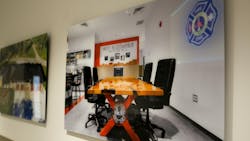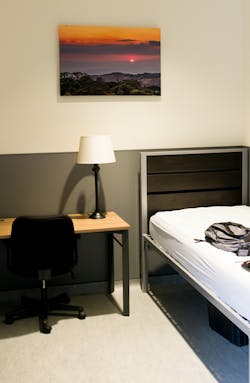Note: This article is part of the Firehouse 2024 Station Design Supplement. To read the entire supplement, click here.
Images that hang on the walls of fire stations often document organizations’ response to some of the most tragic events that occurred within their community. These photographs are reflective of a tradition of commitment to public service. Newspaper clippings, awards and community accolades that sit behind sliding glass panels remind firefighters of their mission.
Although these reminders might evoke a sense of pride, they might displace wall space that could have an even more significant effect on firefighters. The selection of images and artwork to decorate the walls of a fire station presents a chance for aesthetic appreciation and the conveyance of thoughts or feelings. Put another way, finding purpose in the choice of art affects firehouse culture.
Artwork’s broader purpose
Fire station art has reflected the firefighting profession’s culture, values and community spirit for generations. It enhances the station’s aesthetic appeal and embodies the bravery, camaraderie and dedication that are inherent to the field. Artwork that’s selected or created by firefighters can capture the essence of their experiences, triumphs and challenges, which can promote a sense of pride and unity. This visual representation is intended to strengthen the bond among the crew and with the community that the members serve.
Art plays a crucial role in the fire station by fostering an environment that encourages creativity, enriches aesthetic appeal and supports emotional well-being. The strategic placement of art can inspire firefighters, which can spark innovative thinking and problem-solving by providing visual stimulation and a break from the monotony of daily tasks.
Art serves as a tool for personal relaxation and stress reduction and a medium for expressing department identity and values. This strengthens brand perception and fosters a sense of community among firefighters.
Moreover, art in the fire station can enhance the physical environment, which can make that environment more inviting and stimulating, which benefits employees and visitors.
Integrating art into the workplace is a strategic investment in creating a dynamic, inspiring and cohesive work environment.
Positive imagery
Displaying photos of previous emergency scenes in a fire station, although intended to honor the bravery and commemorate significant incidents, carries potential downsides that warrant careful consideration. Pictures of incidents can trigger traumatic memories, and, thus, can reactivate stress and emotional turmoil that’s associated with those events. Repeated exposure might affect mental wellness and contribute to anxiety or depression.
These emotional responses undermine the fire station’s role as a sanctuary for recovery between calls for service. Routine shift exposure could lead to desensitization to violence and suffering or, conversely, increased sensitization, which could heighten emotional distress over time. Organizational culture also might be influenced by photos of emergency scenes, which could reinforce a stoicism culture that stigmatizes vulnerability and emotional distress. This could narrow the organization’s narrative to focus predominantly on dramatic aspects of the job.
Considering these factors, decision-makers could explore alternatives that celebrate a broader range of achievements and incorporate positive imagery to suggest resilience, hope and community spirit. This approach respects the diverse responses of firefighters to such imagery. This can nurture a supportive and resilient organizational culture while honoring their service and sacrifices in a more nuanced and psychologically healthy manner.
Firefighters’ photos
Although the research on art in the workplace is minimal, at least two studies that explored the matter underscore its significant positive effects. A study that was described by Christina Smiraglia in “Artworks at Work: The Impacts of Workplace Art,” which was published in Journal of Workplace Learning, identified five main ways that art affects the workplace: fostering social interactions, enhancing the environment, eliciting emotional responses, enabling personal connections and promoting learning opportunities.
Similarly, in fire stations, integrating art can stimulate conversations, boost morale, and create a more engaging and supportive environment for firefighters. The concept aligns with the broader findings that art in work settings beautifies spaces, strengthens community, supports well-being, and encourages a culture of creativity and reflective learning, emphasizing its importance in critical service areas.
In selecting art for the fire station, incorporating images that are taken by firefighters can personalize the environment deeply, making the selection more meaningful. Rachel Smith, who authored “Art in the Workplace: Why You Need It and How to Choose It,” which was published in Work Design Magazine, wrote that, ideally, such photos should capture serene and uplifting scenes, such as green landscapes, flowing water and open horizons, from an elevated perspective. Including images that reflect care and community, perhaps through depictions of people who are in friendly settings or intergenerational gatherings, also can cultivate a supportive atmosphere. This approach not only decorates the space with visually appealing and mood-boosting art but also celebrates the personal experiences and contributions of the firefighters, which improves their connection to the workplace and to each other.
Image rotation
Displaying photos as artwork in the station offers versatile and cost-effective options, ranging from traditional framed prints to modern acrylic and metal prints. Each medium brings its own aesthetic and atmospheric benefits: Canvas prints evoke a classic, textured feel; acrylics offer sharpness and depth with a contemporary look; metal prints provide durability and a vibrant, glossy finish.
These varied artwork/display options allow customization to match the station’s ambiance, to augment the environment with personal touches, to raise morale, to further a sense of belonging, and to advance a positive, inspiring atmosphere that can benefit both firefighters and the people who visit the station.
The ease of rotating new images—sourced from firefighters’ collections or elsewhere—ensures a dynamic and engaging environment. This flexibility allows for periodic refreshment of the workplace atmosphere, keeping the space vibrant and reflective of current experiences and communal achievements. Such a rotation can lead to continuous engagement and contribution from team members and maintain a lively, evolving backdrop that can prompt creativity and increase the station’s overall sense of unity and pride.
Wall art
Wall art significantly improves a space’s acoustics by absorbing and diffusing sound, which reduces echo and noise levels. Wall art is particularly beneficial in environments such as fire stations, where clear communication is essential. Utilizing canvas, acoustic panels that double as artwork, fabric wall hangings and other such materials can enhance sound quality while adding visual appeal. This dual function of art enriches the workspace aesthetically and acoustically, to create a more comfortable and efficient working environment.
Beliefs & values
Breaking with tradition to refresh art and photos in a station represents a low-cost, low-risk opportunity to rejuvenate the environment and engage the team. Including firefighters in the decision-making process guarantees that the art that’s selected resonates with the crew, which can deliver a sense of ownership and community. This approach allows for exploring new themes and styles, potentially improving the living and work spaces by reflecting current tastes and advancing the culture of resilience and well-being.
Artwork is an example of a cultural artifact or object that represents a particular group. These artifacts embody the beliefs, values and practices of the group. In the context of a fire station, artifacts, such as vintage firefighting equipment, medals and memorial plaques, act as tangible links to a department’s history and values. Art, in the form of one of these artifacts, plays a vital role in connecting the present with the past, celebrating the station’s achievements and inspiring current and future firefighters by visually narrating their collective heritage and dedication. These artifacts might be placed more appropriately in training rooms and public spaces.
Subconscious relief
Carefully selecting and placing art within stations is a powerful strategy to better the working environment and the sense of well-being, creativity and camaraderie among firefighters. By moving beyond traditional displays of emergency scene photographs—which, while honoring bravery, might inadvertently trigger stress and trauma—stations can embrace a more holistic approach to décor. Integrating serene landscapes, abstract designs and uplifting themes offers a respite from the rigors of emergency response, promoting relaxation and mental readiness.
This shift mirrors broader trends in healthcare and other sectors, where art is recognized increasingly for its therapeutic benefits, underscoring the importance of a supportive and aesthetically pleasing environment. Furthermore, engaging firefighters in the selection process can personalize and deepen their connection to the workspace, to bring a vibrant, dynamic atmosphere that’s conducive to reflection, interaction and healing.
As fire stations continue to evolve, the incorporation of art is a testament to the profession’s enduring values of service, resilience and community. It offers a low-cost, impactful means to enrich the lives of those who serve with distinction.
Lessons from Healthcare
The living spaces that are within a fire station require art that offers a respite from continuous exposure to emergencies and mission-focused messaging. Such art can provide a mental break, which can help to reduce stress and to promote relaxation among firefighters during their downtime. Stations can create a more balanced and calming environment by integrating artwork that depicts serene landscapes, abstract designs and themes that are unrelated to the members’ work. This not only aids in mental health and well-being but also ensures that firefighters have a space where they can rejuvenate and maintain their readiness for duty.
Increasingly, hospitals have recognized art’s profound effect on staff and patients, which led to a growing interest in incorporating art within healthcare environments. Art in hospitals serves not just as decoration but as a therapeutic tool to improve the well-being of patients, reducing stress, anxiety and the perception of pain. It creates a more welcoming and less clinical atmosphere, to facilitate healing and comfort.
For healthcare providers, art offers a momentary escape from the high-pressure medical setting, which relieves stress and elevates mental resilience. The presence of art also can improve the work environment. This can contribute to job satisfaction and a positive organizational culture.
Furthermore, hospital art programs often involve patients in the creative process, which can provide a sense of agency and distraction from these individuals’ conditions.
Overall, integrating art in healthcare settings underscores a holistic approach to medicine, acknowledging the interconnection of physical, mental and emotional health in healing.
About the Author

Greg Flynn
Greg Flynn joined the fire service in 1998. He has served his community as a firefighter/paramedic, EMS division captain, assistant chief and fire chief. Flynn has a bachelor's degree in public safety studies and is a National Fire Academy Executive Fire Officer Program graduate.



